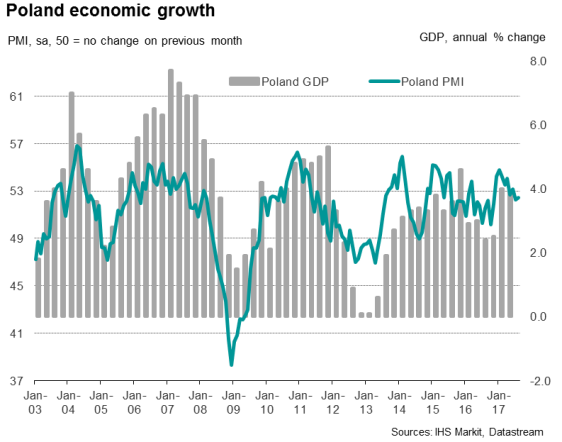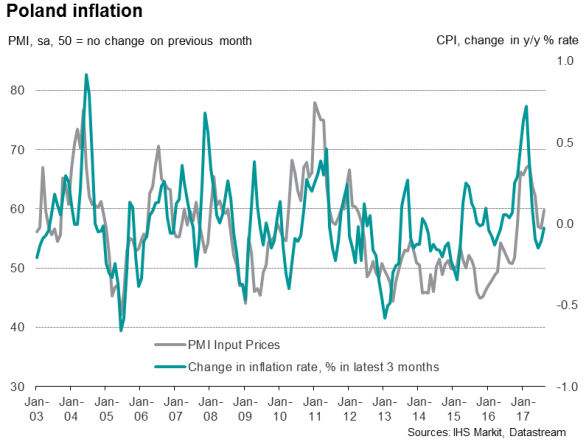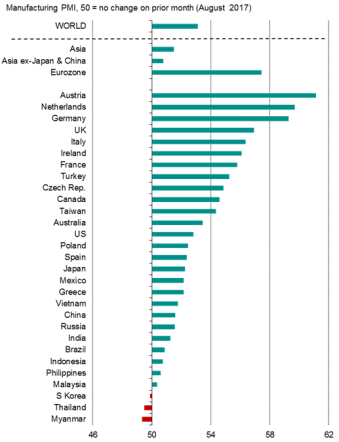Customer Logins
Obtain the data you need to make the most informed decisions by accessing our extensive portfolio of information, analytics, and expertise. Sign in to the product or service center of your choice.
Customer Logins
ECONOMICS COMMENTARY
Sep 14, 2017
Polish PMI indicates slowing growth in the manufacturing sector
Survey data suggest the pace of economic growth in Poland has slowed in the third quarter, but will have remained sufficiently robust to generate further shortages of labour and raw materials. Price pressures have intensified as a result, though the central bank is expected to remain patient in terms of deciding when to start tightening policy.
Growth slowdown in Q2
After a strong start to 2017, Polish manufacturing growth momentum has eased.
The IHS Markit Poland Manufacturing PMI, a closely-watched indicator based on survey data tracking monthly changes in business conditions, remained firmly in expansion territory at 52.5 in August. While the latest reading signalled a relatively robust rate of expansion of the sector, it was below the average seen throughout 2017 so far, and down markedly from a two-year high in January.
The key driver behind the softening in growth has been slower rates of increase in manufacturing output and new orders. Export order growth has also softened.
As manufacturing performance is a key bellwether of the health of the overall economy, with the PMI providing an important gauge of changes in GDP, the survey data suggest that the pace of economic growth is likely to edge down further in the third quarter. Nonetheless, the rate of expansion looks set to remain relatively robust.
While Poland's second quarter GDP figure indicated a slowdown in growth in the economy, in line with the waning IHS Markit Poland Manufacturing PMI trend, both the GDP data and the PMI point to still solid rates of expansion. The annual rate of GDP increase merely dipped from 4.0% in the first quarter (a peak which coincided with the peak in the PMI) to 3.9% in the three months to June.

The expansion was driven by robust growth in household consumption. Loose fiscal policy with schemes such as the Family 500+ child subsidy program, alongside low interest rates encouraged consumers to loosen their purse strings in the first half of the year. IHS Markit forecasts that these effects will ease in the third quarter of 2017, which may lead to a more muted third quarter growth figure.
Labour market tightens further
Employment growth is also showing signs of cooling. August PMI data suggested only a slight rise in the level of manufacturing employment in Poland (Employment Index at 50.9). Anecdotal evidence suggested that Poland's labour market is tightening rapidly, with the official unemployment rate dropping to 7.1% in July. Polish manufacturers responding to the PMI survey frequently noted that they were struggling to employ additional staff due to a shortage of suitable candidates. Backlogs of work consequently rose for the first time in two-and-a-half years as staff shortages meant producers were often unable to keep up with order book growth. It's therefore likely that the tightening of the labour market will lead to rising wage pressures, which would in turn feed through to upward pressure on inflation.
Inflation ticks up
The survey data not only point to rising skill shortages, but supplies of raw materials have also become increasingly difficult to source in recent months as demand has outstripped supply, in part because suppliers lack capacity. Recent data have shown supplier delivery delays to have been more widespread than at any time since early 2011.
With demand exceeding supply, suppliers have been able to hike prices, and the PMI survey has already pointed to a revival of inflationary pressures in industry. Input costs and manufacturers' selling prices both rose at faster rates in August, building on steep price hikes already seen earlier in the year. The trend was matched by the official consumer price inflation rate, which rose to 1.8% in August.
The upturn in price pressures will add to pressure on the central bank to tighten policy. In the first week of September, the National Bank of Poland kept its base interest rate unchanged at a historic low of 1.5%, but the upside risks such as wage inflation pose a threat to the inflation target being overshot. IHS Markit nevertheless anticipates the chance of inflation rising above its target is low, and forecasts that base rate increases will not occur until after mid-2018. The upcoming PMI output and input price indices, which are closely watched by central banks, will provide further insight into Polish inflationary pressures when released on the 2nd October.

Outlook begins to darken
In summary, the IHS Markit Poland Manufacturing PMI points towards slower but still robust GDP growth in the third quarter of 2017. The labour market is set to tighten further, albeit at a slower pace as unemployment falls towards its natural rate. A resulting lack of labour supply may provide upward pressure on wages. Pay rate increases could spill over into inflation; though IHS Markit forecasts that the chance of a significant rise in inflation currently remains limited, though much will depend on how the rising supply constraints feed through to consumer prices in coming months.
In this respect, the next PMI results (due to be released on 2nd October) provide updates to key economic indicators such as price pressures, output and employment. These numbers will signal whether the Polish economy can regain momentum at the end of the third quarter, or remain subdued.

Forthcoming economic data releases:
- September 19th: Industrial production (August)
- September 25th: Unemployment rate (August)
- October 2nd: IHS Markit Poland Manufacturing PMI (September)
Sam Teague | Economist, IHS Markit
Tel: +44 14 9146 1018
sam.teague@ihsmarkit.com
{"items" : [
{"name":"share","enabled":true,"desc":"<strong>Share</strong>","mobdesc":"Share","options":[ {"name":"facebook","url":"https://www.facebook.com/sharer.php?u=http%3a%2f%2fstage.www.spglobal.com%2fmarketintelligence%2fen%2fmi%2fresearch-analysis%2f14092017-Economics-Polish-PMI-indicates-slowing-growth-in-the-manufacturing-sector.html","enabled":true},{"name":"twitter","url":"https://twitter.com/intent/tweet?url=http%3a%2f%2fstage.www.spglobal.com%2fmarketintelligence%2fen%2fmi%2fresearch-analysis%2f14092017-Economics-Polish-PMI-indicates-slowing-growth-in-the-manufacturing-sector.html&text=Polish+PMI+indicates+slowing+growth+in+the+manufacturing+sector","enabled":true},{"name":"linkedin","url":"https://www.linkedin.com/sharing/share-offsite/?url=http%3a%2f%2fstage.www.spglobal.com%2fmarketintelligence%2fen%2fmi%2fresearch-analysis%2f14092017-Economics-Polish-PMI-indicates-slowing-growth-in-the-manufacturing-sector.html","enabled":true},{"name":"email","url":"?subject=Polish PMI indicates slowing growth in the manufacturing sector&body=http%3a%2f%2fstage.www.spglobal.com%2fmarketintelligence%2fen%2fmi%2fresearch-analysis%2f14092017-Economics-Polish-PMI-indicates-slowing-growth-in-the-manufacturing-sector.html","enabled":true},{"name":"whatsapp","url":"https://api.whatsapp.com/send?text=Polish+PMI+indicates+slowing+growth+in+the+manufacturing+sector http%3a%2f%2fstage.www.spglobal.com%2fmarketintelligence%2fen%2fmi%2fresearch-analysis%2f14092017-Economics-Polish-PMI-indicates-slowing-growth-in-the-manufacturing-sector.html","enabled":true}]}, {"name":"rtt","enabled":true,"mobdesc":"Top"}
]}




